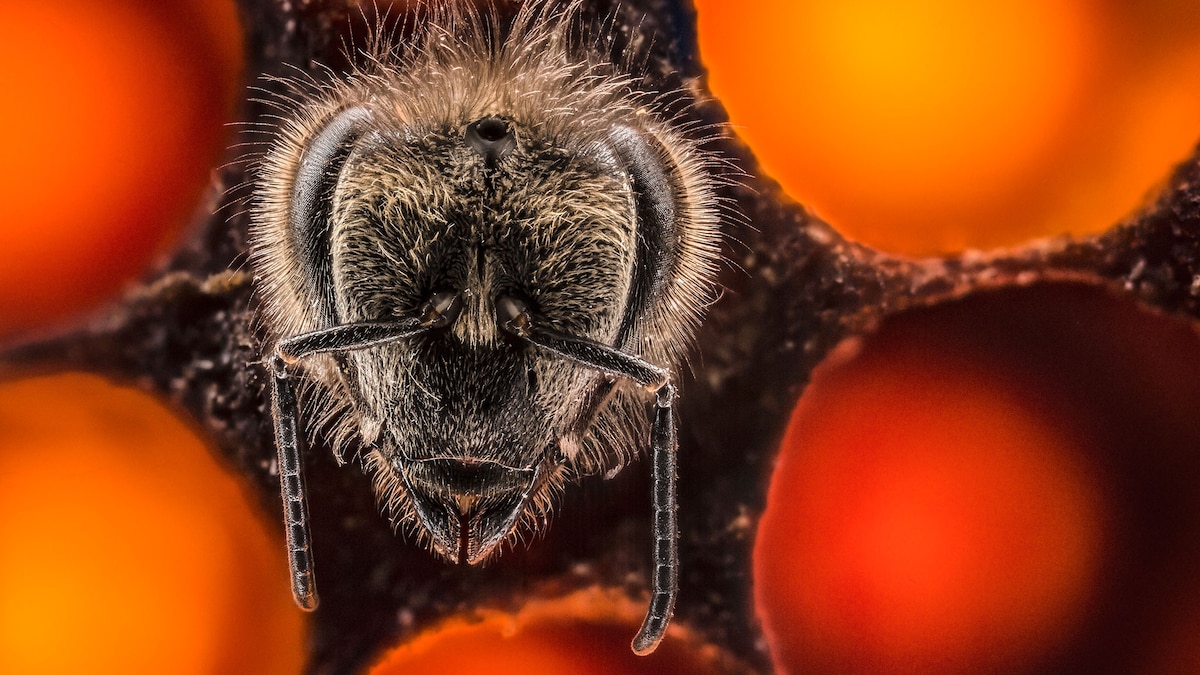I think my love of photographing small things came from my childhood and exploring my backyard. Running over logs and picking up rocks in the creek behind the house where I grew up in Atlanta, Georgia, made me fall in love with this process of exploration and discovery. As much as I thought things like elephants and sharks were cool, the little things—bugs and salamanders—were more accessible and were what I could find myself.
Late in my high school years I borrowed my dad’s camera, which had a macro lens. I took a photo of a garter snake and was able to get details of its scales. Even more than the photo itself, I remember my friend’s reaction to seeing it: he was so excited by all the details. It was the first time I experienced what it was like to share an image and the excitement of discovery.
Macro photography always has the most surprising results because you can expand details beyond what your eyes can see.
A cicada emerging from its exoskeleton (left) and a fragment of a bladderwort, a carnivorous aquatic plant (right).
Here are my best tips for taking great macro photos.
Consider perspective and scale
Always think about surprising your audience. We’re so used to seeing everything from our own standing-height perspective. With macro photography, I like to break that pattern and try to get down at eye level with a subject.
Consider trying to take the picture from the perspective of another creature of the same size, or perhaps even looking up at your subject. If the creature has a face, photographing it at eye level creates a different perspective.
Scale is the real magic sauce of macro photography. Both revealing and obscuring scale can be a powerful way of capturing the attention of your audience.
You can think of scale intentionally, by placing something recognizable–like a fingernail or coin–next to your subject, so your audience can immediately understand the size of what they’re looking at. Alternatively, you can intentionally obscure the scale so it’s hard to tell how big a creature is…that can be fun, too.
Close up of a male Violetcrowned Woodnymph hummingbird (Thalurania columbica) taken at the Tienda las Rosas near the El Dorado Lodge in the Santa Marta Mountains of Colombia.
Shoot at night and with a light source
I always shoot with a light source to direct focus to the subject.
I bring my own light, whether it’s a headlamp, a flashlight or phone light.
It’s often easier to find cool insects and frogs at night since many
are nocturnal. It’s also easier to find them because you’re looking
for them in this much more focused way–you’re not as distracted by all
the details visible in daylight.
Close up of the tentacles of an aggregating anemone in a tide pool at Salt Creek Recreation Area near Port Angeles, Washington.
Parks where you live can provide great inspiration
When it comes to where to shoot, pick a place you’re curious to get to know more intimately. I like going to a familiar place, because macro photography is about making a familiar place unfamiliar and finding surprising details in what otherwise seems mundane and boring.
A natural space—–like woods or a stream, or the neglected edges of a park—–is where you’re most likely to find cool, natural subjects. Even an overgrown lot or sidewalk with weeds growing out if it can be a great place to find interesting little bugs or critters.
Blue water lily pad (Nymphaea nouchali) photographed during the 2018 wetland bird survey led by Steve Boyes across the Okavango Delta, Botswana.
If you’re not too excited about bugs or snakes, then flowers and leaves and plants offer many opportunities for macro photography as well. A nursery or local botanical garden is a really great place to find interesting textures, shapes and colors. Macro photography is one of those ways of teaching ourselves to slow down and notice the details we miss at first glance.
LEAP YEAR SPECIAL
Get a FREE BONUS ISSUE when you subscribe
